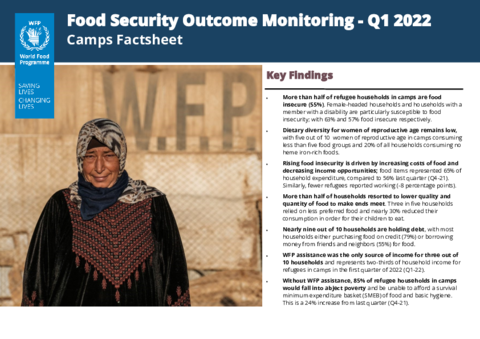
This factsheet provides a summary of the main findings of a Food Security Outcome Monitoring (FSOM) exercise conducted in March 2022 covering households living in the camps.
During Q1 2022, WFP Jordan responded to the food needs of up to 462,488 refugees, 220,775 females and 241,713 males, through the provision of monthly food assistance in the form of cash-based transfers. Assistance was provided in both host communities and camps, covering 349,326 refugees living in communities and 113,499 refugees living in camps. To ensure that assistance is effective, efficient, relevant, and aligned with organizational commitments towards protection and inclusion, the WFP Jordan Country Office conducts quarterly food security outcome monitoring (FSOM) exercises covering WFP beneficiaries in Jordan.
- More than half of refugee households in camps are food insecure (55 percent). Female-headed households and households with a member with a disability are particularly susceptible to food insecurity; with 63 percent and 57 percent food insecure respectively.
- Without WFP assistance, 85 percent of refugee households in camps would fall into abject poverty and be unable to afford a survival minimum expenditure basket (SMEB) of food and basic hygiene. This is a 24 percent increase from last quarter (Q4-21).
